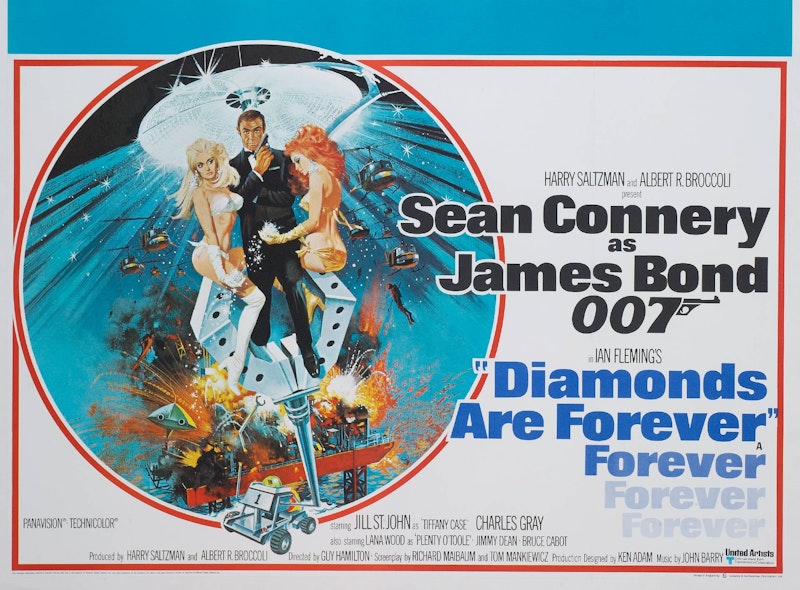James Bond started fighting the evil criminal organization SPECTRE in his first movie, in 1962, and kept after the bastards in each sequel. But following his seventh film from Eon Productions, 1971’s Diamonds Are Forever, legal issues over a disputed copyright would hold SPECTRE out of the movies for decades. SPECTRE was, and is, a handy invention: apolitical villains, they keep the Bond stories from dating too badly. They’d be missed, but at least they got something like a satisfactory ending to their tale in 1971.
SPECTRE isn’t mentioned onscreen in Diamonds Are Forever, but the film revolves around the conflict between Bond and SPECTRE mastermind Ernst Stavro Blofeld. Blofeld killed Bond’s wife in the previous movie, so there’s a personal stake in the battle for agent 007, even beyond destroying the criminal group he’s fought for nine years. That should make for an entertaining action-thriller. But the emotional arc remains rudimentary, the dead wife isn’t mentioned, and the film doesn’t really work.
The original novel, published in 1956 well before the creation of SPECTRE, is a dull affair in which Bond’s assigned to stop some diamond smugglers and comes in conflict with mobsters in the United States. The movie loosely adapts the book in its early parts, but to its benefit soon veers off to a more science-fictional plot.
It opens with Bond pursuing Blofeld and apparently killing him, before Bond’s assigned to track down diamond smugglers. That takes him to Amsterdam and then Las Vegas, theoretically undercover as a smuggler in cahoots with lovely Tiffany Case (Jill St. John). He investigates a casino called the Whyte House, owned by Willard Whyte (Jimmy Dean), a cloistered billionaire reminiscent of Howard Hughes, who Bond learns also owns a research lab with projects underway involving lasers and satellites. It turns out the smuggled diamonds are actually for use in constructing space lasers, and Whyte’s been replaced by Blofeld (Charles Gray) who survived the opening minutes of the movie after all. There are car chases, a desert death trap, queer-coded assassins, and an explosive climax on a private oil rig.
The movie’s directed by Guy Hamilton, who oversaw Goldfinger; but this film doesn’t match that one. The script was first developed by veteran Bond screenwriter Richard Maibaum, but was reworked entirely by Tom Mankiewicz after producer Albert R. Broccoli had a dream about a Hughes lookalike. The result isn’t smooth, clunkily shifting gears between the relatively grounded diamond-smuggling plot, the surrealism of Las Vegas, and the weirdness of high-tech labs and laser weapons.
And the pacing’s leaden. For the first time Peter R. Hunt is neither editor nor director, and while Bert Bates and John W. Holmes do a professional cutting job, their work doesn’t have the same thrill. It’s a more ponderous movie, and bringing Sean Connery back as James Bond doesn’t help. Connery’s clearly not interested in the material (beyond the payday, he was promised he could pick his next two films if he did this one) and at 40 doesn’t bring the kind of physicality he did in earlier films. The IMDB suggests this is the first Bond movie where Connery didn’t have his eyebrows trimmed, and you notice it.
Ken Adams returns as production designer, but the world of 1971 is a different from the 1960s. Cars are boxier, fashions duller, and the secret labs and lairs more cramped. Diamonds never comes alive with the visual inventiveness of the 60s films. Some of that’s the location. Where earlier films were set in Europe or Japan or the Caribbean, here we get the tackiness of early-70s Las Vegas, a Vegas not old-fashioned enough to be charming, its casinos and hotels merely tawdry for all the bright lights and sideshow acts. The fundamentally ersatz quality of the place gives the movie an ersatz feel. It’s all cheap tinsel.
It doesn’t help that the movie struggles to find a balance between popular and lurid. In 1962 Dr. No debuted in a world where Ursula Andress could become a sex symbol by walking out of the ocean in a white bikini. By 1971 movie theaters were showing hardcore pornography. Bond struggles here to maintain a libertine air, with slightly coarser double-entendres (Bond tells a woman “You have something I’d like you to get off your chest,” then strangles her with her bikini top). It’s an odd mixed bag: two minor characters are assassins played as gay (by Bruce Glover and Putter Smith), and Bond has an actual fight with two women, but when he takes a knee in the balls it’s still kept off-screen. The word “bastard” can’t be said in full.
The action has some nice moments, including the infiltration of Whyte’s lab and subsequent escape in a moon rover, and a large-scale car chase through Las Vegas. Unfortunately the ending on the oil rig’s underwhelming; the place isn’t much of a supervillain lair, there’s some pointless fiddling-about with a cassette tape to keep the plot moving, and you wonder why the United States doesn’t just chuck some missiles at the base and call it a day.
Then there’s Blofeld, also a disappointment. Once again he’s out for cash, using space lasers to extort money. And once again that’s anticlimactic. Rather than just profit from a successful diamond smuggling ring, Blofeld’s got an unlikely scheme to raise money from a plan that could instead have given him world power. You want to see more vision from a villain.
The revenge angle’s underplayed for most of the movie, and Connery can’t be bothered to carry the film (perhaps excepting the moment when he talks his way into Whyte’s secret lab through the power of confident tall white masculinity). He seems tired, and as a result so does the movie.

